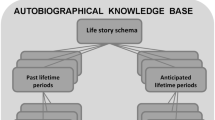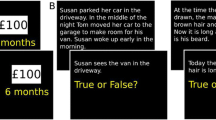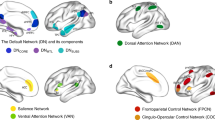Abstract
Patients with damage to the ventromedial prefrontal cortex (VMPFC) are often described as having impaired ability for planning and decision making despite retaining intact capacities for explicit reasoning. The somatic marker hypothesis is that the VMPFC associates implicitly represented affective information with explicit representations of actions or outcomes. Consequently, when the VMPFC is damaged explicit reasoning is no longer scaffolded by affective information, leading to characteristic deficits. These deficits are exemplified in performance on the Iowa Gambling Task (IGT) in which subjects with VMPFC perform significantly worse than neurotypicals in a task which requires them learn from rewarding and punishing experience to make decisions. The somatic marker theory adopts a canonical theory of emotion, in which emotions function as part of a valencing system, to explain the role of affective processes. The first part of the paper argues against this canonical account. The second part provides a different account of the role of the role of the VMPFC in decision-making which does not depend on the canonical account of emotion. Together the first and second parts of the paper provide the basis for a different interpretation of results on the Iowa Gambling Task (IGT). In fact the IGT may be probing a deficit in what has been called mental time travel: the ability to access and use information from previous experience and imaginatively rehearse future experiences as part of the process of deliberation.
Similar content being viewed by others
References
Bayley P.J., Hopkins R.O., Squire L.R. (2006). The fate of old memories after medial temporal lobe damage. Journal of Neuroscience 26:13331–13337
Bechara A., Damasio A.R. (2005). The somatic marker hypothesis: A neural theory of economic decision. Games and Economic Behaviour 52:336–372
Bechara A., Damasio H., Damasio A., et al. (1999). Differential contributions of the human amygdala and ventromedial prefrontal cortex to human decision-making. The Journal of Neuroscience 19:5473–5481
Berridge K.C., Robinson T.E. (2003). Parsing reward. Trends in Neuroscience 26:507–513
Braver T.S., Barch D.M., et al. (1999). Cognition and control in schizophrenia: A computational model of dopamine and prefrontal function. Biological Psychiatry 46:312–328
Braver T., Cohen J. (1999). On the control of control: The role of dopamine in regulating prefrontal function and working memory. In: Monsell S., Driver J. (eds). Attention and performance XVIII: Control of cognitive processes. Cambridge, MA: MIT Press, pp. 713–737
Clayton N.S., Bussey T., et al. (2003). Can animals recall the past and plan for the future? Nature Reviews Neuroscience 4:685–691
Colombetti G. (2005). Appraising valence. Journal of Consciousness Studies 12:8–10
D’Argembeau A., Van der Linden M. (2006). Individual differences in the phenomenology of mental time travel: The effect of vivid visual imagery and emotion regulation strategies. Consciousness and Cognition 15(2):342–350
Damasio A.R. (1994). Descartes’ error: Emotion, reason and the human brain. New York, Putnam
Damasio A., Tranel D., et al. (1990). Individuals with sociopathic behaviour caused by frontal lobe damage fail to respond autonomically to socially charged stimuli. Behavioural and Brain Research 14:81–94
Damasio A.R., Tranel D., et al. (1991). Somatic markers and the guidance of behaviour: Theory and preliminary testing. In: Levin H.S., Eisenberg H.M., Benton A.L. (eds). Frontal lobe function and dysfunction. New York, Oxford University Press, pp. 217–229
Dunn B.D., Dalgleish T., Lawrence A.D. (2006). The somatic marker hypothesis: A critical evaluation. Neuroscience and Biobehavioural Reviews 30:239–271
Egelman D.M., Person C., Montague P.R. (1998). The computational role of dopamine delivery. Journal of Cognitive Neuroscience 10:623–630
Eichenbaum H. (1998). Amnesia, the hippocampus and episodic memory (editorial). 8:197
Faulkner, D., & Foster, J. K. (2002). The decoupling of “explicit” and “implicit” processing in neuropsychological disorders: Insights into the neural basis of consciousness?. Psyche, 8(2), http://psyche.cs.monash.edu.au/v8/psyche-8-02-faulkner.html.
Frith C.D. (1996). The role of the prefrontal cortex in self-consciousness: The case of auditory hallucinations. Proceedings of the Royal Society of London 351(B):1505–1512
Gabrieli J.D.E., Keane M.M., Zarella M.M., Poldrack R.A. (1997). Preservation of implicit memory for new associations in global amnesia. Psychological Science 8:326–329
Grace A. (1991). Phasic versus tonic dopamine release and the modulation of dopamine responsivity: A hypothesis of the etiology of schizophrenia. Neuroscience 41:1–24
Graf P., Schacter D. (1985). Implicit memory for new associations in normal and amnesic subjects. Journal of Experimental Psychology: Learning, Memory and Cognition 11:501–518
Gutbrod K., Krouzel C., Hofer H., et al. (2006). Decision-making in amnesia: Do advantageous decisions require conscious knowledge of previous behavioural choices? Neuropsychologia 44(8):1315–1324
Heims H., Critchley H., et al. (2004). Social and motivational functioning is not critically dependent on feedback of autonomic responses: Neuropsychological evidence from patients with pure autonomic failure. Neuropsychologia 39:521–524
Kapur S., Craik F.I.M., Jones C., Brown G.M., Houle S., Tulving E. (1995). Functional role of the prefrontal cortex in retrieval of memories: A PET study. Neuroreport 14:1880–1884
Keane M.M., Gabrieli J.D.E., Mapstone H., Johnson K.A., Corkin S. (1995). Double dissociation of memory capacities after bilateral occipital-lobe or medial temporal-lobe lesions. Brain 118:1129–1148
Klein S.B., Loftus J., et al. (2002). Memory and temporal experience: The effects of episodic memory loss on an amnesic patient’s ability to rememberrthe past and imagine the future. Social Cognition 20:353–379
Knight R.T. (1999). Prefrontal cortex regulates inhibition and excitation in distributed neural networrks. Acta Psychiatrica Scandinavia 101:159–178
Levine B., Turner G.T., Tisserand D.J., Graham S.I., Hevenor S.J., McIntosh A.R. (2004). The functional neuroanatomy of episodic and semantic autobiographical remembering: A prospective study. Journal of Cognitive Neuroscience 16:1633–1646
Levine B., Freedman M., Dawson D., Black S.E., Stuss D.T. (1999). Ventral frontal contribution to self-regulation: Convergence of episodic memory and inhibition. Neurocase 5:263–275
Maia T.V., McClelland J.L (2004). A reexamination of the evidence for the somatic marker hypothesis: What participants really know in the Iowa gambling task. Proceedings of the National Academy for Science USA 10:16075–16080
Maia T.V., McClelland J.L. (2005). The somatic marker hypothesis: Still many questions but no answers. Trends in Cognitive Science 9:162–164
Miller E., Cohen J.D. (2001). An integrative theory of prefrontal cortex function. Annual Review of Neuroscience 24:167–202
Moore H., Grace A. (1999). The regulation of forebrain dopamine transmission: Relevance to the pathophysiology and psychopathology of schizophrenia. Biological Psychiatry 46:40–55
O’Reilly R., Munakata Y. (2000). Computational explorations in cognitive neuroscience. Cambridge, MA: MIT Press
Schultz W., Dayan P., Montague P.R. (1997). A neural substrate of prediction and reward. Science 275:1593–1599
Schweinberger S., Burton M. (2003). Covert recognition and the neural system for face processing. Cortex 39:9–30
Smith A., Li M., Becker S., Kapur S. (2006). Dopamine, prediction error, and associative learning: A model-based account. Network: Computation in Neural Systems 17:61–84
Steinvorth S., Corkin S., et al. (2006). Ecphory of autobiographical memories: An fMRI study of recent and remote memory retrieval. NeuroImage 30(1):285–298
Suddendorf T. (2006). Foresight and evolution of the human mind. Science 312:1006–1007
Suddendorf T., Busby J. (2003). Mental Time Travel in Animals. Trends in Cognitive Sciences 7:391–396
Suddendorf T., Busby J. (2005). Making decisions with the future in mind: Developmental and comparative identification of mental time travel. Learning & Motivation 36:110–125
Suddendorf T., Corballis M.C. (1997). Mental time travel and the evolution of the human mind. Genetic, Social, and General Psychology Monographs 123:133–167
Suddendorf, T., & Corballis, M. C. (in press). The evolution of foresight: What is mental time travel and is it unique to humans? Behavioral and Brain Sciences (in press).
Tomb I., Hauser M., Deldin P., Caramazza A. (2002). Do somatic markers mediate decisions on the gambling task?. Nature Neuroscience 5:1103–1104
Tranel D., Damasio A.R. (1988). Knowledge without awareness: An autonomic index of facial recognition in prosopagnosics. Science 228:1453–1454
Tulving E. (2002). Episodic Memory: from mind to brain. Annual Review of Psychology 53:1–25
Wallis J.D., Miller E.K. (2003). Neuronal activity in primate dorsolateral and orbital prefrontal cortex during performance of a reward preference task. European Journal Neuroscience 18:2069
Waltz J., Knowlton B., Holyoak K., Boone K., Mishkin F., De Menezes Santos M., Thomas C., Miller B. (1999). A system for relational reasoning in the prefrontal cortex. Psychological Science 10:119–125
Wheeler M.A., Stuss D., Tulving E. (1997). Toward a theory of episodic memory: The fronal lobes and autonoetic consciousness. Psychological Bulletin 121:331–354
Wood J., Grafman J. (2003). Human prefrontal cortex. Nature Reviews Neuroscience 4:139–147
Young A.W., Burton A.M. (1999). Simulating face recognition: Implications for modelling cognition. Cognitive Neuropsychology 16:1–48
Zentall T.R. (2006). Mental time travel in animals: a challenging question. Behavioral Processes 72:173–183
Author information
Authors and Affiliations
Corresponding author
Rights and permissions
About this article
Cite this article
Gerrans, P. Mental time travel, somatic markers and “myopia for the future”. Synthese 159, 459–474 (2007). https://doi.org/10.1007/s11229-007-9238-x
Accepted:
Published:
Issue Date:
DOI: https://doi.org/10.1007/s11229-007-9238-x




